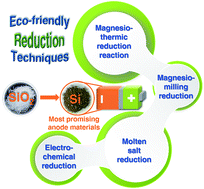Silicon: toward eco-friendly reduction techniques for lithium-ion battery applications
Abstract
Silicon-based anode materials have been intensively studied over the past few decades owing to their exceptionally high specific capacity. However, silicon (Si) mainly exists as Si(IV) in the form of silica (SiO2) or silicates in nature. The current industrial production methods of Si mainly cater to solar energy and semiconductor industry applications, and they usually suffer from high energy consumption in order to produce ultra-high purity Si. Therefore, developing efficient reduction techniques for producing Si, especially nanostructured Si (Nano Si) with comparable cost and scalability, is fundamentally desirable for the commercialization of Si anodes. In recent years, several pioneering avenues have been established to explore the fabrication of Si and Nano Si in regard to anode materials. A few environmentally friendly and cost-effective reduction strategies such as magnesiothermic reduction, magnesio-milling reduction, molten salt reduction, and electrochemical reduction have been developed. In this review, we summarize the progress on current reduction approaches, including the detailed mechanism, reaction conditions, and the relationship between the diverse morphologies and electrochemical performance. The current synthetic challenges and future research directions based on these routes are summarized, which is of great significance to the fundamental research and industrial application of Si-based anode materials.

- This article is part of the themed collection: Recent Review Articles


 Please wait while we load your content...
Please wait while we load your content...